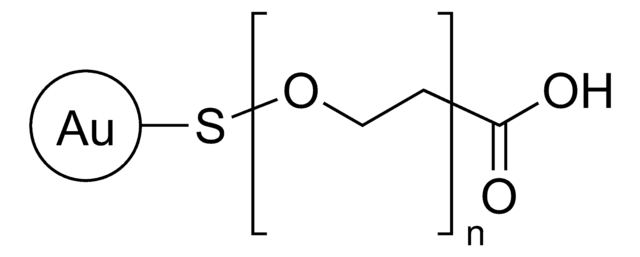765325
Gold nanoparticles
15 nm diameter, amine functionalized, PEG 5000 coated, OD 50, dispersion in H2O
Sinônimo(s):
Gold nanoparticles NH2 functionalized, Au NP NH2, Gold Colloid
About This Item
Produtos recomendados
Materiais
PEG 5000
Nível de qualidade
Formulário
dispersion in H2O
nanoparticles
embalagem
poly bottle of 1 mL
DO
50
diâmetro
15 nm
pH
6.0-8.0 (25 °C)
solubilidade
water: miscible
densidade
1.00 g/cm3
λmax
520 nm
grupo funcional
amine
temperatura de armazenamento
2-8°C
Procurando produtos similares? Visita Guia de comparação de produtos
Categorias relacionadas
Descrição geral
Aplicação
Características e benefícios
- A negatively charged siRNA-PEG complex, attached to positively charged GNPs, is easily cleavable in reductive cytosolic environment thus enabling the release of siRNA into cytosol.
- The PEG coating, decreases the cytotoxicity and increases efficiency of GNPs. PEG increases the stability of the nanoparticles and prevents agglomeration.
Código de classe de armazenamento
10 - Combustible liquids
Classe de risco de água (WGK)
WGK 2
Ponto de fulgor (°F)
Not applicable
Ponto de fulgor (°C)
Not applicable
Escolha uma das versões mais recentes:
Certificados de análise (COA)
Não está vendo a versão correta?
Se precisar de uma versão específica, você pode procurar um certificado específico pelo número do lote ou da remessa.
Já possui este produto?
Encontre a documentação dos produtos que você adquiriu recentemente na biblioteca de documentos.
Artigos
The recent emergence of a number of highly functional nanomaterials has enabled new approaches to the understanding, diagnosis, and treatment of cancer.
Biomaterials science involves the design and fabrication of smart materials for studying, directing, or mimicking biology. For successful integration of biomaterials in biological research, a meaningful understanding of biological systems is required.
Nossa equipe de cientistas tem experiência em todas as áreas de pesquisa, incluindo Life Sciences, ciência de materiais, síntese química, cromatografia, química analítica e muitas outras.
Entre em contato com a assistência técnica


